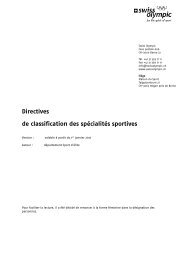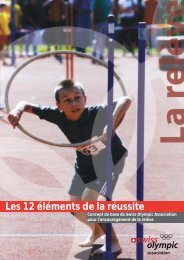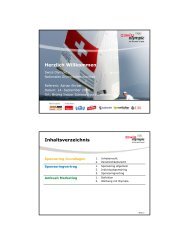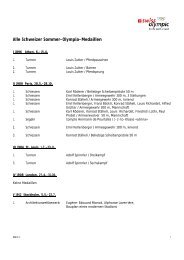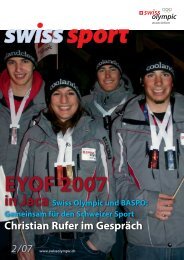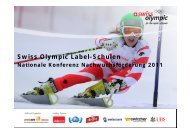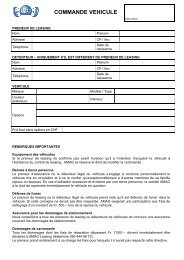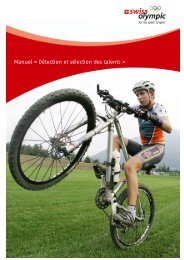Diagnostic de la performance d'endurance - Swiss Olympic
Diagnostic de la performance d'endurance - Swiss Olympic
Diagnostic de la performance d'endurance - Swiss Olympic
Create successful ePaper yourself
Turn your PDF publications into a flip-book with our unique Google optimized e-Paper software.
Contrôle <strong>de</strong> qualité <strong>Swiss</strong> <strong>Olympic</strong><br />
SWISS OLYMPIC MEDICAL CENTERS<br />
29. Fay L. et al.; Physiological parameters re<strong>la</strong>ted to distance running <strong>performance</strong> in female<br />
athletes ; Med Sci Sports Exerc: (21) 319-324, 1989<br />
30. Scott B. et al.; Peak Running Velocity is Highly Re<strong>la</strong>ted to Distance Running Performance ; Int<br />
J Sports Med: (15) 504-507, 1994<br />
31. Hawley J. and Noaks T.; Peak power output predicts maximal oxygen uptake and<br />
<strong>performance</strong> time in trained cyclists; Eur J Appl Physiol: (65) 79-83, 1992<br />
32. Noaks T. et al.; Peak treadmill velocity during VO2max test predicts running <strong>performance</strong> ; J<br />
Sports Sci: (8) 35-45, 1990<br />
33. Held T. , Marti B.; Substantial Influence of Level of Endurance Capacity in the Association of<br />
Perceived Exertion with Blood Lactate Accumu<strong>la</strong>tion; Int J Sports Med.; (20) 34-39, 1999<br />
34. Foxdal et al. ; Comparison of Blood Lactate Concentrations Obtained During Incremental and<br />
Constant Intensity Exercise ; Int J Sports Med : (17) 360-365, 1996<br />
35. Urhausen A. et al.; Aktuelle Marker für die Diagnostik von Über<strong>la</strong>stungszustän<strong>de</strong>n in <strong>de</strong>r<br />
Trainingspraxis; Dtsch Z Sportmed: (51) 226-233; 2000.<br />
36. Meyer T. et al.; Is <strong>de</strong>termination of exercise intensities as percentages of VO2max or Hrmax<br />
a<strong>de</strong>quate? Med Sci Sports Exerc; (31), 1342-1345, 1999<br />
37. Weltman A.,et al.; Percentages of Maximal Heart Rate, Heart Rate Reserve and VO2max for<br />
Determining Endurance Training Intensity in Male Runners; Int J Sports Med: (11) 218-<br />
222,1990<br />
38. Katch V., Sady St., Freedson P.; Biological variability in maximum aerobic power; Med Sci<br />
Sports Exerc: (14), 21-25, 1982<br />
39. Held T.; Datenbank; SWI Magglingen;2000<br />
40. Zavorsky G.; Evi<strong>de</strong>nce and Possible Mechanisms of Altered Maximum Heart Rate With<br />
Endurance Training and Tapering; Sports Med: (29) 13-26, 2000<br />
41. Held T. , Marti B.; Einfluss <strong>de</strong>s Dauerleistungsvermögens auf die Herzfrequenz während und<br />
nach Laufbandstufentest; Schweiz. Z. Sportmed. Sporttraumat.: 19-23, 1995<br />
42. Boutellier U. and Spengler Ch.; VO2max als Mass für die Ausdauerleistungsfähigkeit ?:<br />
Schweiz. Z. Sportmed. Sporttraumat.; (47)118-122, 1999<br />
43. Farrell P. et al.; P<strong>la</strong>sma <strong>la</strong>ctate accumu<strong>la</strong>tion and distance running <strong>performance</strong>; Med Sci<br />
Sports Exerc: (11) 338-344, 1979<br />
44. Tho<strong>de</strong>n J.; Testing Aerobic Power; in ‘Physiological Testing of High-Performance Athlete’,<br />
MacDougall J., Wenger H., Green H.; Human Kinetic, Champaign , Illinois: 107-0174, 1991<br />
45. Denis C. et al. ; Effects of 40 Weeks of Endurance Training on th Anaerobic Thershold ; Int J<br />
Sports Med : (3) 208-214 ; 1982<br />
46. Sjodin et al.; Changes in the onset of blood <strong>la</strong>ctate accumu<strong>la</strong>tion (OBLA) and muscles<br />
enzymes after training at OBLA ; Eur J. Appl. Physiol: (49) 45-57, 1982<br />
47. Howley E., Bassett D., Welch H.; Criteria for maximal oxygen uptake: review and commentary;<br />
Med Sci Sports Exerc: (27) 1292-1301, 1995<br />
48. Duncan G., Howley E., Johnson B.; Applicability of VO2max criteria: discontinuos versus<br />
continuos protocols; Med Sci Sports Exerc: (29)273-278, 1997<br />
49. McConnell T.: Practical Consi<strong>de</strong>rations in the Testing of VO2max in Runners; Sports Med: (5)<br />
57-68, 1988<br />
50. Marti B., Laukkanen R., Held T.; Beurteilung <strong>de</strong>r Ausdauer aufgrund <strong>de</strong>r VO 2max : Standard <strong>de</strong>s<br />
BASPO; Schweiz. Z. Sportmed. Sporttraumat.; (4): 173-174, 1999<br />
51. Pfitzinger P and Freedson P. S.; The Reliability of Lactate Measurements During Exercise; Int<br />
J Sports Med: (19) 349-357, 1998<br />
52. Heitkamp H.-Ch et al.; The Reproducibility of the 4 mmol/l Lactate Threshold in Trained and<br />
Untrained Women; Int J Sports Med: (12) 363-368, 1991<br />
53. Paton C. D., Hopkins W. G.; Tests of Cycling Performance; Sports Med.: (7) 489-496, 2001<br />
54. Mühlebach R.: Unterschie<strong>de</strong> <strong>de</strong>r Leistung, sowie <strong>de</strong>s Herzfrequenz-Laktat-und VO2max.-<br />
Verhaltens bei unterschiedlichen Testprotokollen auf <strong>de</strong>m Fahrra<strong>de</strong>rgometer. Inaugural-<br />
Dissertation, Medizinischen Fakultät Universität Zürich: 1999.<br />
55. Coen B., Urhausen A., Kin<strong>de</strong>rmann W.: Individual Anaerobic Threshold: Methodological<br />
Aspects of its Assesment in Running. Int. J. Sports Med., 22: 8-16, 2001.<br />
56. Feliu J., Ventura JL., Segua R., Rodas G., Riera J., Estruch A., Zamora A., Cap<strong>de</strong>vi<strong>la</strong> L.:<br />
Differences between <strong>la</strong>ctate concentration of samples from ear lobe and the finger tip. J.<br />
Physiol. Biochem., 12: 333-339, 1999.<br />
27




